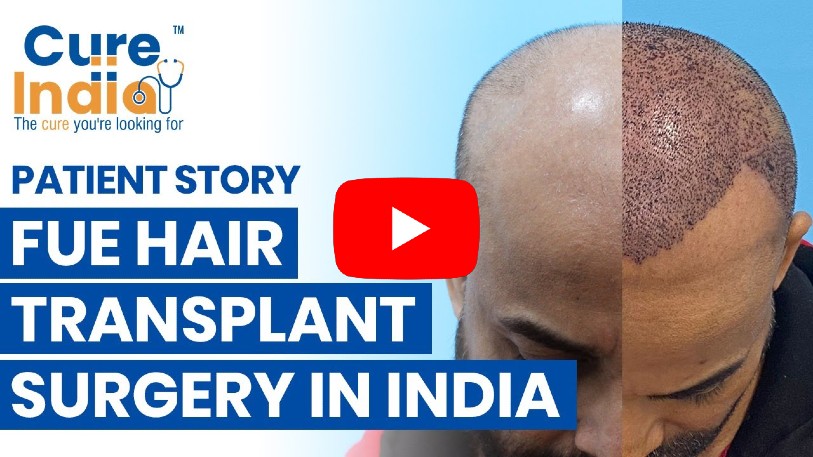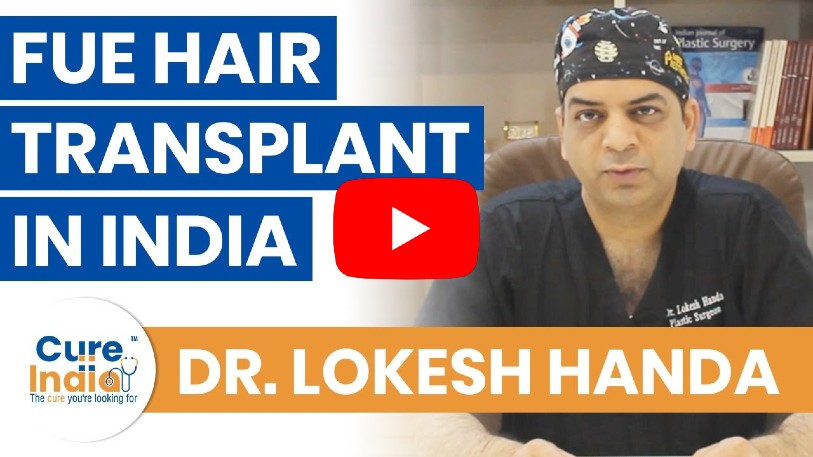

A hair transplant is the best way to retrieve hair volume and appear youthful. More than 2.2 million people had regained hair through hair transplants as per a 2022 survey. Below is a comprehensive guide to planning hair transplants at a reasonable hair transplantation costs in India.
Content Index
FUE Hair Transplant Cost | Surgery Techniques | FUE Hair Transplant Package | Complimentary Services | Our Cosmetic Surgeons | How to Start | FAQs
.png)
Hair loss is on the rise across the world. More men are being affected by hair loss as compared to women and most often hair loss is directly affecting one’s confidence. More and more people are getting conscious about their looks and would want to look younger and more presentable at their work and social circle. A lot of people are searching how much does a hair transplant cost, and are overwhelmed with the options and prices.
Our objective is to bring you the latest and the most effective techniques in hair transplant ensuring the highest level of care and attention at an affordable hair transplant price in India. Transform your look with advanced and effective hair transplant services by top surgeons in India. You will be surprised to know the fue hair transplant cost in India.
We provide you with all the information about hair transplants that helps you understand the right hair fall treatment for you. This, in turn, allows you to make an informed choice based on your needs and goals. Most people think that the procedure of a Hair Transplant will put their long-term savings at the end. Well, it’s not the case if you opt for Indian medical services. If you know how much does a hair transplant cost in India, you won't have to think twice to book your flights and get it done at accredited clinics here in India.



Thinking about how much hair transplantation costs in India? The costs of most of the surgeries can come as a surprise to a lot of patients from the USA or European nations. Questions can arise on the parameters like quality of surgery, care, or final results.
You will be glad to know that India provides the best value for money when it comes to medical treatments. Hair transplant surgery cost in India will definitely bring savings. You can compare how much does a hair transplant cost in India vs. USA / UK / Australia.
| Procedure | Cost in USA / UK / Australia | Cost in India | Cost Savings |
|---|---|---|---|
| Hair Transplant | $6,000 - $15,000 | $3,000 | 80% |
The advanced amenities provided by India's hospitals are supported by the country's modern infrastructure. Outpatient and inpatient services are available, with a choice of accommodation types ranging from many comfortable beds to luxurious suites. Digital diagnostic laboratories and imaging centers, blood banks, emergency medical services, ambulance services, Wi-Fi on campus, multi-cuisine cafeterias, and prayer rooms are all available at hospitals associated with CureIndia.
We have internationally trained renowned doctors who specialize in hair transplants. The best team of experts from all over India will be there to help you in this procedure. Our mission is to provide quality services at budget-friendly hair transplant surgery cost in India. Here are our best and most experienced doctors:



Hair transplant is a type of surgery that involves moving existing hair to fill in areas where there is thin or no hair. A hair transplant can help you look better. India is one of the best places to go for hair treatments. This also includes hair transplant, an unconventional method of regaining hair made possible by science's miracles. Every year, a number of international patients travel to India solely to have their hair problems resolved. When it comes to hair transplantation in India, cosmetic surgery clinic is one of the most reputable names. Hair transplant charges in India are lower with the advanced service qualities you expect.
Hair transplant for women can increase their self-confidence. Most women experience diffuse hair loss, which is characterized by thinning in all areas of the head, including the sides and back, which serve as donor sites in men. Hair is removed from these areas in preparation for transplantation to other parts of the head.
Thanks to one significant advancement, it is now possible to achieve natural-looking results. Hair transplantation aims to give those suffering from hair loss a more youthful appearance. Natural-looking results can also be achieved by improving the hairline and placing the hairs in the thinning areas.
You might be interested in hair restoration treatment and wonder how long it will take for a hair transplant to show results and 'How long does a hair transplant last'?
The grafts used in hair transplant surgery are taken from parts of the head where they are genetically predisposed to continue growing. The transplanted hair follicles maintain their original properties and continue to grow for the rest of their lives, even after being implanted in the bald parts of the scalp. A hair transplant can last a lifetime with the appropriate surgeon and the necessary aftercare.
Although permanent hair loss treatments like FUT and FUE hair transplant surgeries are an option, it is normal for patients to have many procedures throughout their hair restoration. There are few hair donors on the sides and back of the head, making it difficult to replace all the lost hair throughout a lifetime.
Many patients seeking a hair loss treatment ask, 'How much does a hair transplant cost?' The FUE hair transplant cost for treating hair loss issues can be very high and strain your finances. The average hair transplant cost in the USA is $7,500, which often goes as high as $25,000 in the UK, the USA or in Australia. However, CureIndia assists you in saving 80% for the same procedure. Hair transplantation is the most excellent option for treating severe hair loss. People who are particularly self-conscious about their looks often seek treatment for hair loss through hair transplantation.
Hair transplants are typically not covered by health insurance. This is because it is a non-life-threatening elective surgical operation. Although it's not frequently seen as a medical necessity, if it were, your insurance might pay for the hair transplant price.
The concept of medical necessity under public health insurance may differ depending on the rules and regulations of the state. Similar to how various private health insurance companies define what is a medical necessity, so do consumers.
Your health insurance might cover hair implants for men cost if you've lost hair because of a medical condition, your severe hair loss is a result of an accident or burns, or you are in mental distress or suffering from gender dysphoria because of your hair loss. You must obtain all the evidence required to prove that your hair transplant is a medically necessary procedure.
Hair transplantation is divided into two types:
A strip of skin will be removed from the donor area and stitches will be used to close the incision. The donor skin will then be separated into tiny follicular units using a microscope. The follicular units will contain one or more hair follicles and insert these units into the desired area using a microscope.
The surgeon will remove follicles from the donor area with a tiny punch tool. Although there will still be some scarring after this procedure, it will be less noticeable, and stitches are not usually required.
Manual FUE and Robotic FUE are the two types of FUE hair transplants. A physician performs a manual FUE hair transplant with a handheld device. A robotic hair transplant device is used in a Robotic FUE procedure, which is guided by the physician. The doctor determines the amount of hair to be harvested and draws a map of the desired donor area. The ARTAS robot does the actual harvesting of the donor grafts, not the physician. This technological marvel in medicine provides unrivaled precision and accuracy. The success rate of the procedure with Robotic FUE technology can be as high as 100%. The success of the procedure is determined by the doctor's skill, knowledge, and experience, and Indian surgeons are found to be highly experienced in carrying out Robotic FUE. CureIndia will assist you with the procedure by the most skilled doctor at low hair transplant charges in India.
1). Stop smoking and consuming alcohol before surgery.
2). Before your surgery, avoid getting your hair cut.
3). Massage your scalp before your surgery.
4). You will have to take medications prescribed by the doctor.
5). Before your surgery, stop taking aspirin or any anti-inflammatory medication.
6). Before surgery, avoid antidepressants, beta-blockers, and blood thinners.
7). Stop taking herbal supplements or multivitamin/mineral supplements before surgery.
1) Your doctor will do the procedure with follicular unit strip surgery (FUSS) or follicular unit extraction (FUE).
2) The skin from the back of your head is removed with FUSS.
3) The surgeon's team then divides the removed scalp strip into 500 to 2,000 tiny grafts, each containing one or a few hairs.
4). The number and type of grafts you receive are determined by your hair type, quality, color, and the size of the area where the transplant is being performed.
5). The doctor then one by one removes the hair follicles when performing FUE. Small dots heal the area, which your existing hair will cover.
6). Following that, both procedures are identical. The surgeon cleans and numbs the area where the hair will go, creates holes or slits with a scalpel or needle, and carefully places each graft in one of the holes after preparing the grafts. The procedure will take between 4 and 8 hours, depending on the size of the transplant.
1). The scalp may be very tender after surgery. It's possible that you'll have to take pain relievers for several days.
2). For at least a day or two, your surgeon will provide you with bandages over your scalp.
3). They might also give you an antibiotic or an anti-inflammatory to take for a few days.
4). Most patients return to regular work around 2 to 5 days after surgery.
5). The transplanted hair will fall out two to three weeks after surgery, but new growth should appear within a few months.
6). After 6 to 9 months, most people will see 60% new hair growth. Some surgeons may provide medications to improve hair growth.
It is crucial to stay informed throughout your experience if you are thinking about having hair transplant surgery. For those who qualify, a hair transplant can change their lives. Hair transplant surgery is the best choice for those who want to regrow or restore their natural hair. Medical research has advanced to the point where hair transplant surgeries are more accurate and natural-looking than ever before, providing men and women with more options when coping with hair loss.
You must be physically healthy to endure a medical operation and have a robust immune system before considering surgery. Many aspirants often ask, 'Does a hair transplant hurt.' Before such a surgery, you must know what to expect and what not to expect. The amount of hair you've already lost, and the amount of donor's hair you have available to transplant to the thinning parts of your head are two of the most crucial elements in assessing if you're a good hair transplant women or men candidate.
1). You can reach out to us by one of the following methods:-
a) Tapping the WhatsApp button blinking on the website. Or connect manually at +91 8448560641
b) Drop an email to us at support@cureindia.com
c) Call our international helpline +91 9555887700
d) Leave an by filling an enquiry form on our website
2). As soon as you reach us, our case manager will get back to you within 24 hours. We gather your requirements and clinical images(if needed), and discuss them with our cosmetic surgeons. We will get back to you with a cost estimate and treatment plan.
3). We book your appointment as per your travel schedule and make all necessary arrangements.
4). We pick you up at the New Delhi Airport on the day of your arrival, and the medical travel process starts.


Tummy Tuck, Breast lifts and Rhinoplasty
Be The New You
Female Only Clinics for Sensitive Patients
Full Privacy
Dermal Fillers, Laser, Anti Wrinkle Injections
Say No To Ageing